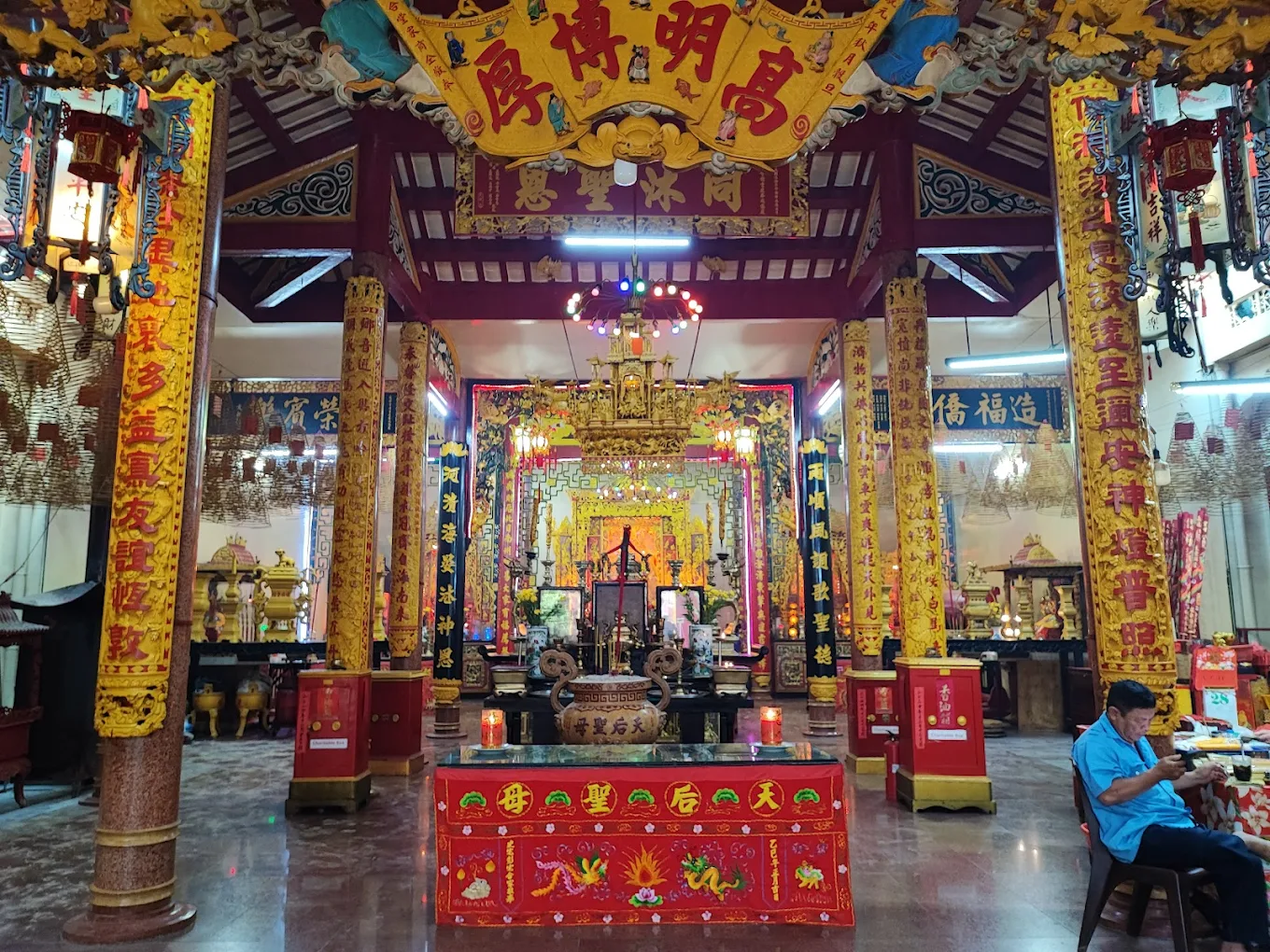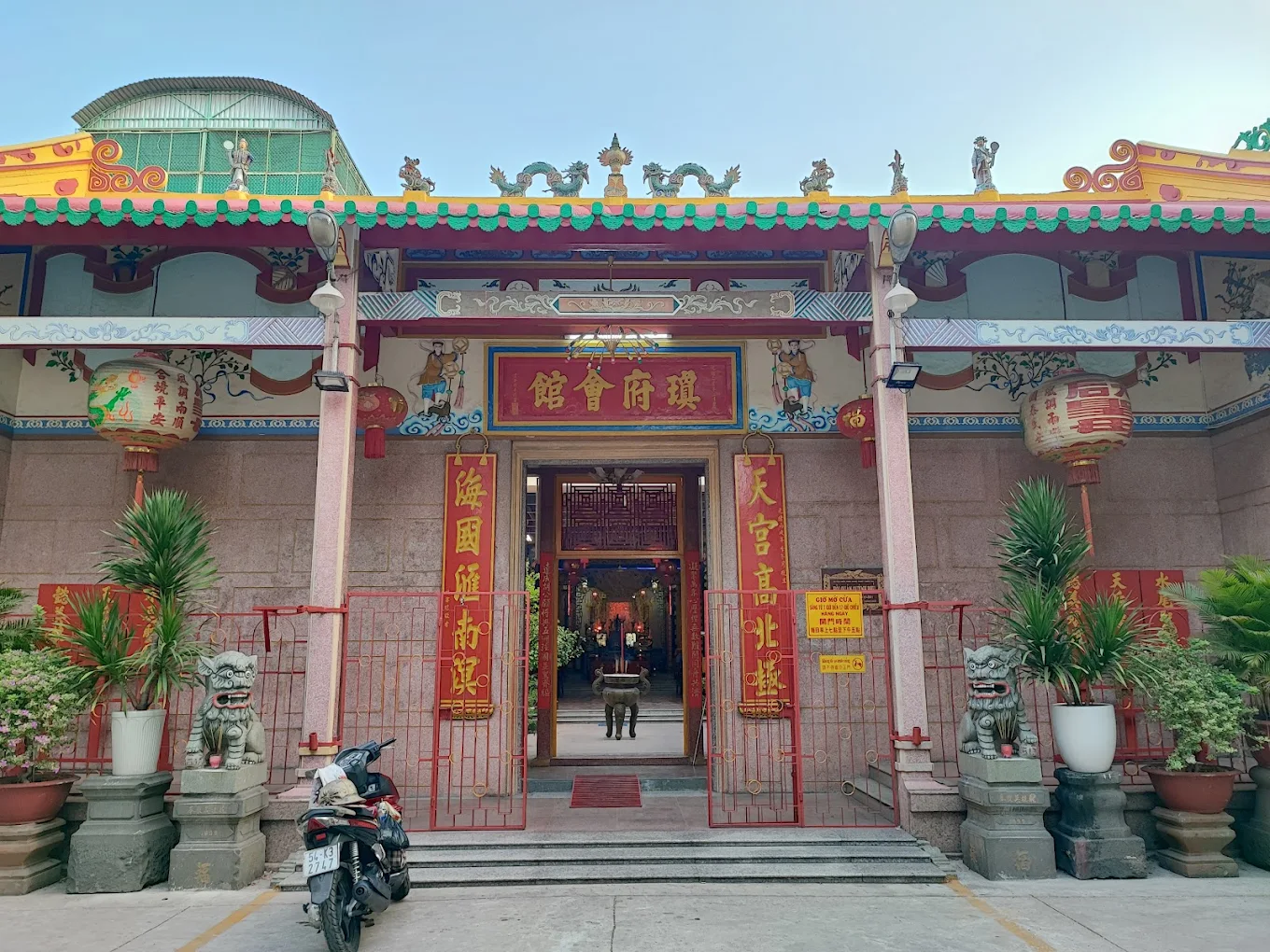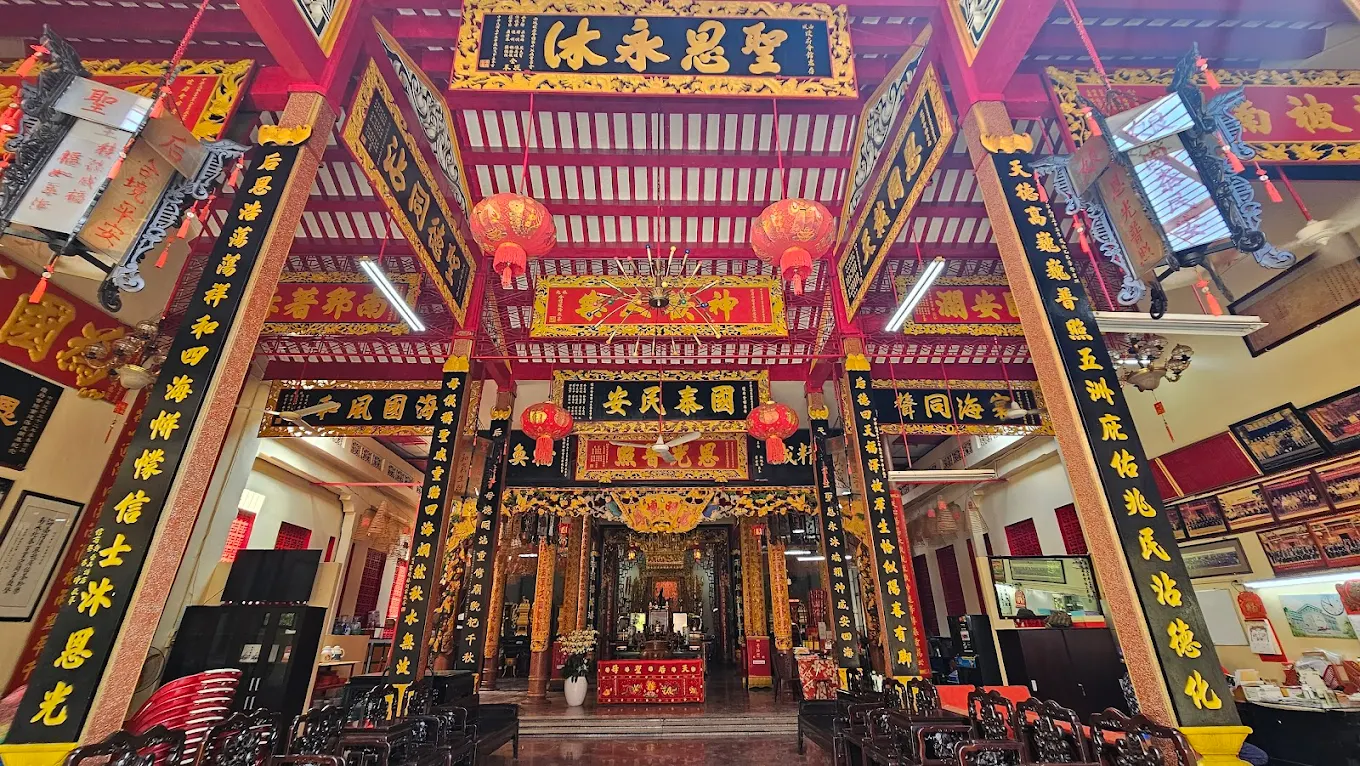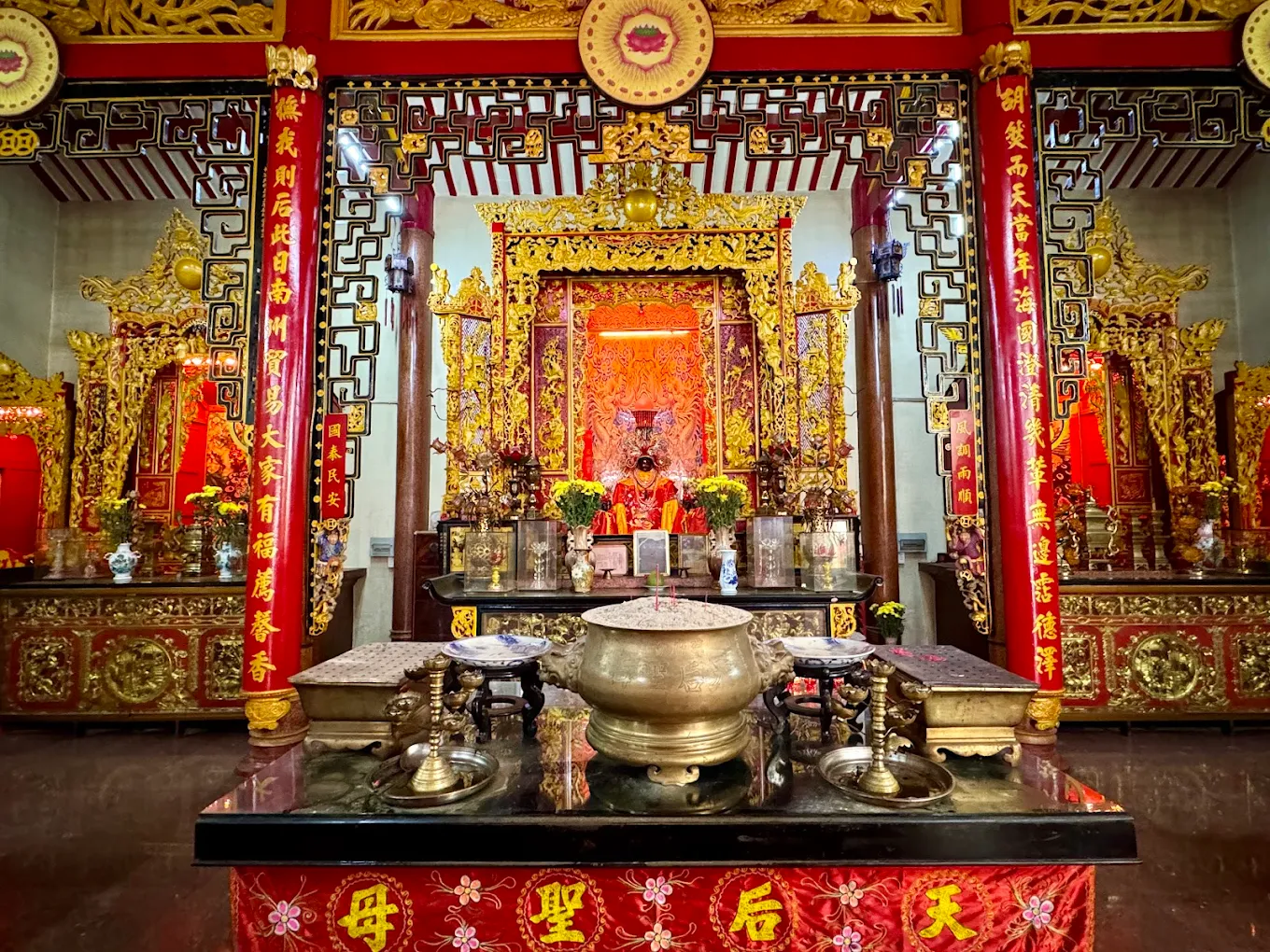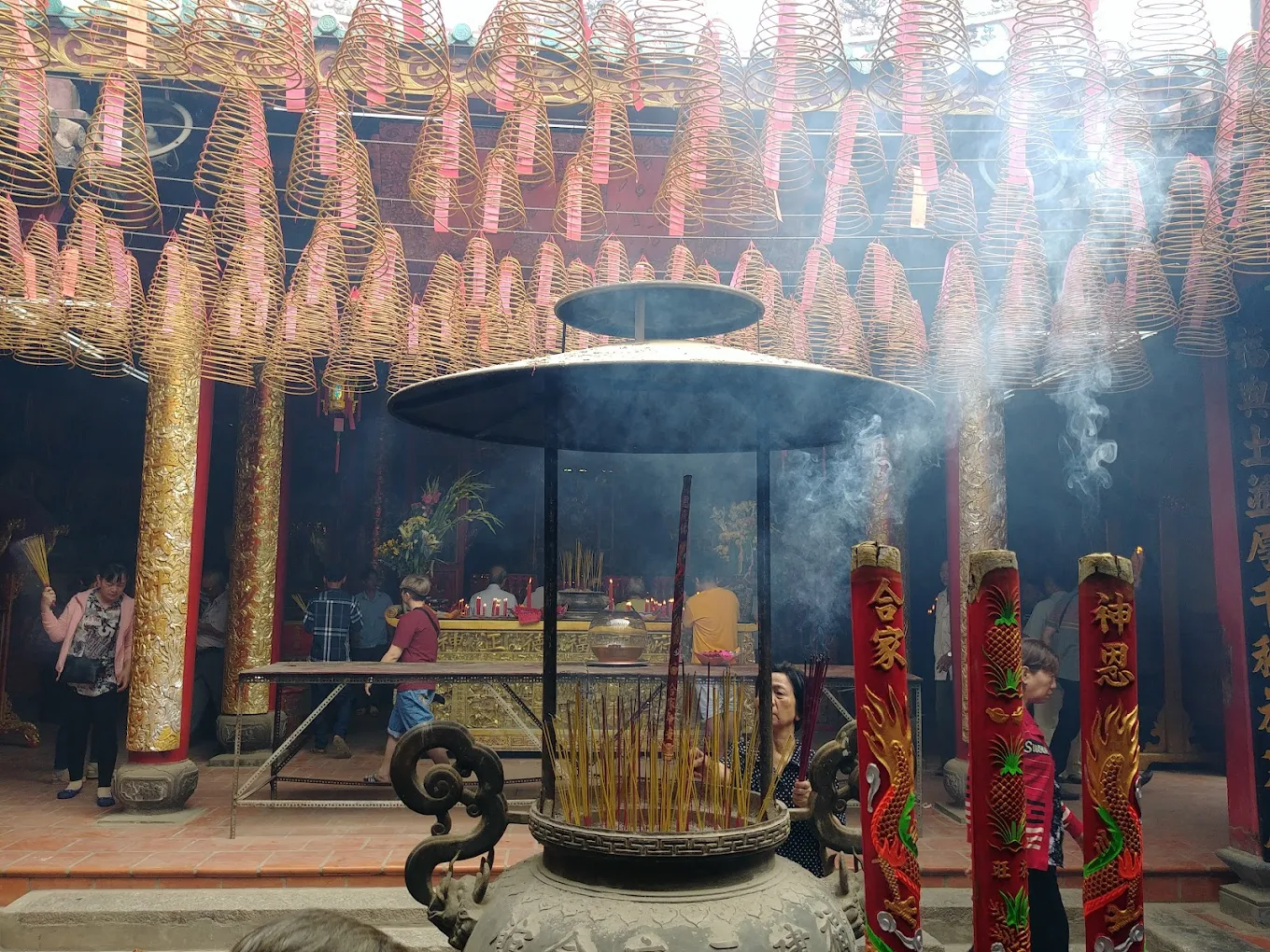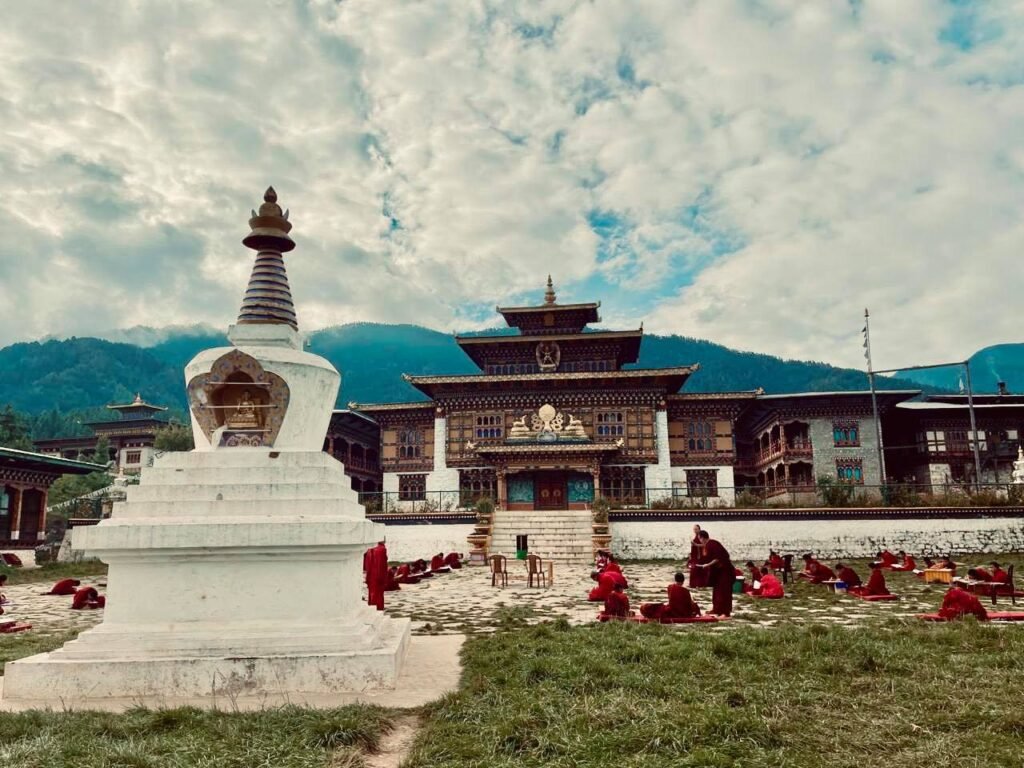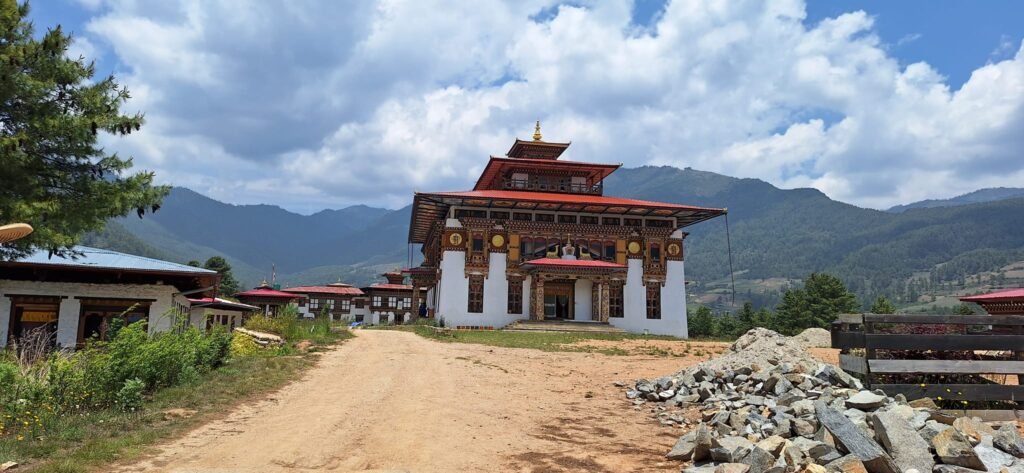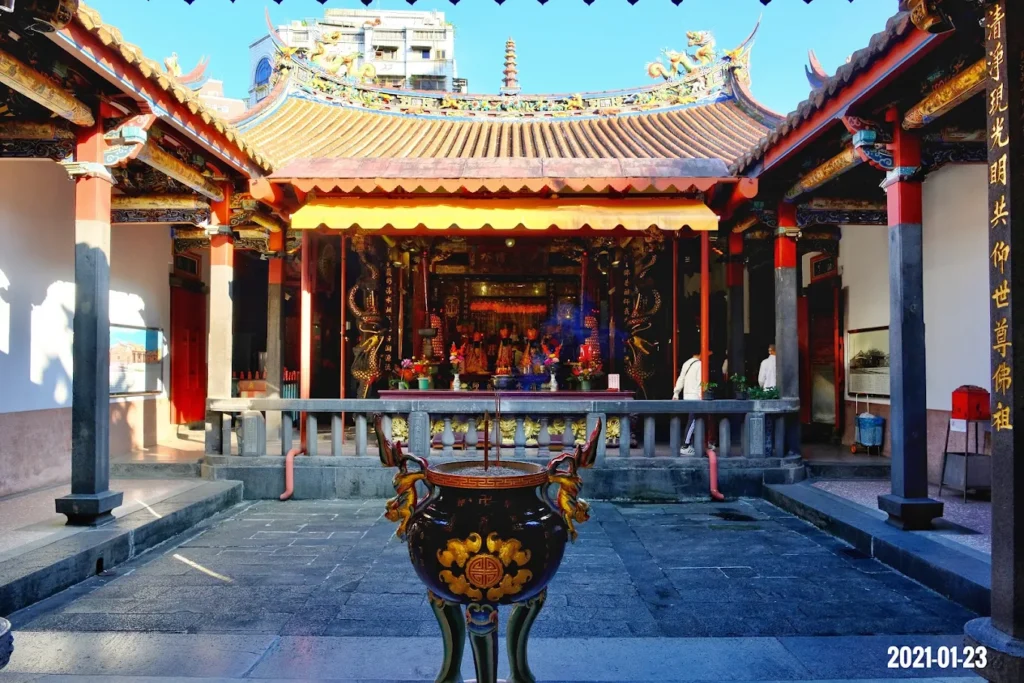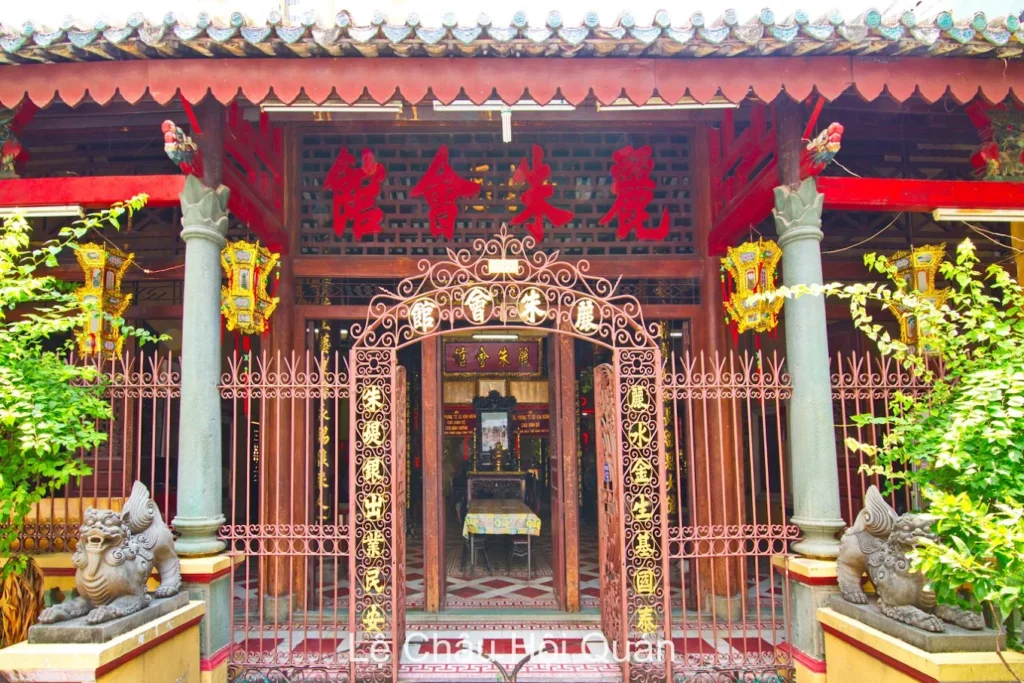Quỳnh Phủ Pagoda: A Sacred Haven of Hainanese Devotion in Chợ Lớn
At 276 Trần Hưng Đạo Street in Chợ Lớn’s vibrant heart, Quỳnh Phủ Pagoda [Hội Quán Quỳnh Phủ] stands as a sacred haven, its dragon-adorned roof and swirling incense coils enveloping the serene statue of the Goddess of the Sea [Thiên Hậu Thánh Mẫu] in a glow of Hainanese devotion. Monks arrange roasted pig offerings [heo quay] before her altar, while red lanterns cast a warm light over ceramic carvings [khắc gốm] of mythical creatures like Two Dragons Chasing the Pearl [Lưỡng Long Tranh Châu]. The gentle hum of a 19th-century incense burner [lư hương] blends with prayers, creating a peaceful retreat amid Ho Chi Minh City’s bustling District 5. Built in 1824 by immigrants from Qiongzhou, Hainan, China, and recognized as a national heritage site in 2001, this pagoda weaves Hainanese artistry with Buddhist spirituality, inviting visitors to explore Quỳnh Phủ Pagoda’s rich heritage.,
Overview and Significance
Introduction to Quỳnh Phủ Pagoda
Quỳnh Phủ Pagoda, also known as Chùa Bà Hải Nam or Hội Quán Quỳnh Phủ, is a cornerstone of Northern Mahayana Buddhism and Hainanese Chinese culture in District 5, Ho Chi Minh City, celebrated for its devotion to the Goddess of the Sea [Thiên Hậu Thánh Mẫu], also known as Mazu, a revered deity in Chinese culture believed to protect sailors and merchants from ocean dangers. Founded in 1824 by immigrants from Qiongzhou, a historic name for Hainan Island, China, a tropical region known for its maritime trade, the pagoda’s name reflects its roots in Qiongzhou’s seafaring community. Northern Mahayana, a Buddhist tradition emphasizing compassion and enlightenment, blends with Taoist and Hainanese folk beliefs, creating a unique spiritual tapestry. Covering over 2,000 square meters, the pagoda attracts thousands yearly for prayer, festivals, and cultural exploration, its red-and-gold Hainanese design a hallmark of East Asian artistry. Recognized as a national architectural and artistic heritage site in 2001, Quỳnh Phủ Pagoda anchors Chợ Lớn’s cultural identity, inviting visitors to immerse in its traditions.,,
The pagoda’s significance lies in its role as a spiritual and community hub for the Hainanese diaspora, fostering unity through rituals like roasted pig offerings and festivals such as Thiên Hậu Festival [Lễ Vía Thiên Hậu], held on the 23rd day of the third lunar month, celebrating the Goddess of the Sea with prayers, roasted pig offerings, and dragon dances, uniting the community in devotion. Its main hall [chánh điện], adorned with carved wooden screens [bao lam] and horizontal inscribed boards [hoành phi], showcases centuries of craftsmanship, while its charity, like funding schools and offering rice to the poor, strengthens its social impact. The courtyard’s stone lions, symbolizing protection, contrast with District 5’s bustling markets like Hòa Bình Market, offering a serene space for reflection. Quỳnh Phủ Pagoda’s blend of history, spirituality, and artistry makes it a must-visit for those seeking to explore Quỳnh Phủ Pagoda history, connecting Hainanese heritage with Vietnam’s vibrant present.,
Historical Journey
Quỳnh Phủ Pagoda’s story began in 1824, when Hainanese immigrants from Qiongzhou, Hainan, China, built it as a hội quán—a community hall for worship and support—in Chợ Lớn, Ho Chi Minh City’s historic Chinese district. Constructed with wooden beams and stone, it honored the Goddess of the Sea, the Lady of the Water’s Edge [Thủy Vĩ Thánh Nương], the Lady of Grace [Ý Mỹ Nương Nương], and the 108 Sacred Souls [108 anh linh], spirits of merchants wrongfully killed, believed to protect seafarers, reflecting Hainan’s maritime traditions. A 19th-century stone tablet records donations from Hainanese merchants, highlighting early unity, as noted in local records.,
Renovations in 1831, 1871, 1875, 1937, and 1954 preserved its Hainanese architecture, with the 1871 renovation adding ceramic carvings like Two Dragons Chasing the Pearl, as documented in inscriptions. During the 1960s and 1970s, monks hid relics, including a 19th-century incense burner, in alcoves to protect them during wartime. The 1954 renovation, funded by community donations, restored the pagoda’s vibrant colors and reinforced its structure, earning its national heritage status in 2001. Today, the management board oversees charity and cultural activities, keeping the pagoda a spiritual anchor.
This journey reflects the Hainanese community’s resilience, from establishing a new home in Vietnam to safeguarding their heritage. Each renovation preserved the pagoda’s identity, from its dragon-adorned roof to its calligraphic boards, making it a beacon for those seeking to explore Quỳnh Phủ Pagoda history and Chợ Lớn’s multicultural past.,
Cultural Significance
Quỳnh Phủ Pagoda is a spiritual haven in District 5, offering peace amid the lively Hòa Bình Market, where vendors’ calls fade into the temple’s calm. Its daily prayers to the Goddess of the Sea, rooted in Northern Mahayana Buddhism and Hainanese Taoist traditions, draw devotees seeking protection and prosperity. The pagoda’s festivals, like Lantern Festival [Tết Nguyên Tiêu], celebrated on the 15th day of the first lunar month, marking the first full moon with lanterns, incense, Hainanese opera, and lion dances; Thiên Hậu Festival, honoring the Goddess of the Sea; and Vu Lan Festival [Lễ Vu Lan], held in the seventh lunar month to honor ancestors with offerings of rice, flowers, and roasted pig offerings, rooted in the Buddhist tale of Maudgalyayana saving his mother, attract thousands from Ho Chi Minh City and beyond. These events unite families, reflecting Vietnam’s spiritual values.,
The pagoda’s unique worship of the 108 Sacred Souls, tied to Hainan’s seafaring legends, sets it apart, as noted in local guides. Its ceramic carvings and horizontal inscribed boards influence Chợ Lớn’s cultural identity, drawing scholars and tourists to explore Quỳnh Phủ Pagoda’s heritage. Its charity, like supporting schools with 1 billion VND yearly, embeds it in District 5’s community, making it a key destination for those seeking to discover its traditions.,,
Unique Legacy
Quỳnh Phủ Pagoda’s legacy blends spirituality, artistry, and resilience:
- Goddess of the Sea Worship: Her statue symbolizes protection, drawing devotees for safe travels, a Hainanese tradition.
- Community Resilience: Over 200 years, community-funded renovations preserved its heritage through challenges.
- Hainanese Artistry: Ceramic carvings and calligraphic boards, blending Chinese and Vietnamese styles, set a cultural standard in Chợ Lớn.
This legacy captivates visitors seeking to explore Quỳnh Phủ Pagoda history, making it a cultural beacon in District 5.,
Community and Global Impact
Quỳnh Phủ Pagoda fosters community ties in District 5, hosting daily prayers and monthly gatherings that unite Hainanese and Vietnamese devotees. During Lantern Festival, Thiên Hậu Festival, and Vu Lan Festival, diaspora from Singapore and Malaysia join to offer incense, strengthening global ties. Its architecture and charity draw scholars, elevating its profile for those seeking to discover Quỳnh Phủ Pagoda. Charity initiatives, like rice distributions, make it a vital hub for local and global communities.,
Historical Anecdotes
- Seafarers’ Gratitude: Hainanese merchants built the pagoda in 1824 to thank the Goddess of the Sea for safe voyages, as shared by the management board.
- 1871 Donation: A stone tablet records merchant contributions, symbolizing unity.
- Wartime Preservation: Monks hid relics during the 1960s–1970s, preserving heritage.
These stories enrich Quỳnh Phủ Pagoda history, captivating visitors.,
Social Role
The pagoda hosts charity events, like rice distributions, aiding District 5 families. Monthly gatherings foster mindfulness, while festivals strengthen ties, making it a center for those seeking to immerse in Quỳnh Phủ Pagoda traditions.
Artistic Influence
Ceramic carvings and horizontal inscribed boards inspire Chợ Lớn artisans, influencing temple designs. Art exhibitions feature the pagoda’s carved wooden screens, showcasing Quỳnh Phủ Pagoda architecture’s impact. Its Hainanese aesthetics draw visitors to explore its heritage.,
The pagoda’s history and culture flow into its architecture, blending spirituality and artistry.
Architectural and Spiritual Features
Iconic Design
Quỳnh Phủ Pagoda’s Quốc-shaped layout [chữ Quốc], a Chinese design with three parallel buildings forming a rectangular enclosure, spans over 2,000 square meters, symbolizing harmony and balance, reflecting Hainanese architectural principles from Qiongzhou, Hainan, China. Its red, gold, and green tiles contrast with District 5’s bustle. The dragon-adorned roof, with ceramic carvings of Two Dragons Chasing the Pearl, symbolizes divine power. The courtyard’s stone lions, symbolizing protection, create a serene focal point, making Quỳnh Phủ Pagoda architecture a spiritual haven.,,
The layout includes a front hall [tiền điện], sky well [thiên tỉnh], and main hall, flanked by east and west wings, with the west wing once housing Văn Trang School, now Trần Hữu Trang High School. Ceramic carvings and stone lions at the entrance add protection, while lanterns illuminate the courtyard. Recognized as a national heritage site in 2001, this design invites visitors to explore Quỳnh Phủ Pagoda architecture’s tranquil beauty.
Key Structures
- Main Hall: Adorned with carved wooden screens [bao lam], it houses the Goddess of the Sea statue, amplifying prayers.
- Front Hall: Features a 19th-century incense burner, flanked by altars to the Lady of the Water’s Edge and Lady of Grace.
- Sky Well: Lets light illuminate the main hall, symbolizing clarity.
- East and West Wings: Host community spaces and altars to the 108 Sacred Souls, reflecting the pagoda’s role as a hội quán.
These structures anchor Quỳnh Phủ Pagoda architecture, inviting exploration.
Worshipped Statues/Deities
- Goddess of the Sea [Thiên Hậu Thánh Mẫu]: A 1.5-meter statue symbolizes protection, drawing devotees for safe travels.
- Lady of the Water’s Edge [Thủy Vĩ Thánh Nương]: A statue symbolizes coastal safety, revered for harmony.
- Lady of Grace [Ý Mỹ Nương Nương]: A statue embodies benevolence, attracting prayers for peace.
- 108 Sacred Souls [108 anh linh]: A shrine honors protective spirits, drawing devotees for safety.
These figures inspire reverence, enhancing the appeal for those seeking to visit Quỳnh Phủ Pagoda.
Materials and Techniques
Ceramic carvings from Hainan and Bát Tràng resist humidity, depicting Two Dragons Chasing the Pearl. Wooden statues, carved from jackfruit wood [gỗ mít], reflect craftsmanship. The 1871 renovation added stone pillars; 1954 restored tiles and beams. Horizontal inscribed boards bear prayers like “Hải Bình Vạn Niên,” showcasing devotion. The incense burner adds historical depth, resonating with those exploring Quỳnh Phủ Pagoda architecture.,
Signature Elements
The Goddess of the Sea statue, dragon-adorned roof, and stone lions define the pagoda, recognized in its 2001 heritage status, captivating visitors seeking to immerse in its traditions.
Lesser-Known Features
- Stone Lions: 19th-century statues symbolize protection, often overlooked.
- Calligraphic Boards: Boards with prayers add cultural richness.
- Incense Burner: A 19th-century relic reflects devotion.
These elements enrich the pagoda’s spiritual tapestry.,
Preservation Efforts
The 1954 renovation, funded by donations, restored carvings and tiles. Monks maintain screens with natural oils, ensuring endurance. Recent waterproofing protects the roof, preserving Quỳnh Phủ Pagoda for future generations.
Environmental Integration
The courtyard’s stone lions and trees create tranquility, aligning with phong thủy. The sky well’s light connects nature and spirituality, inviting meditation for those seeking to visit Quỳnh Phủ Pagoda.
Artisan Narratives
Hainanese artisans crafted carvings in 1871, while 1954 vendors restored beams, blending styles. Their work resonates with visitors exploring Quỳnh Phủ Pagoda architecture.,
Symbolic Details
The Goddess of the Sea signifies protection, Two Dragons Chasing the Pearl harmony, and lanterns hope, deepening the spiritual experience.
Landscape Integration
The 2,000-square-meter courtyard shields the temple from District 5’s noise, with benches for contemplation, inviting visitors to immerse in Quỳnh Phủ Pagoda’s peaceful atmosphere.
The pagoda’s architecture sets the stage for its vibrant rituals, inviting engagement with Hainanese traditions.
Rituals and Practices
Daily Sacred Rites
Each morning at 6:00 a.m., monks pray to the Goddess of the Sea, lighting incense burners to create a warm glow. Devotees offer roasted pig offerings and incense for protection, anchoring Quỳnh Phủ Pagoda rituals. The incense burner’s smoke carries prayers, open to visitors with monks’ guidance, fostering a meditative experience.
Monks arrange flowers and fruits before altars, maintaining the courtyard for phong thủy. Chants create a serene backdrop, inviting those seeking to visit Quỳnh Phủ Pagoda to connect with its traditions.
Unique Practices
- Incense Coil Offerings: Devotees hang incense coils, burning for weeks to seek continuous blessings, a Hainanese tradition, open to visitors.
- Roasted Pig Offerings [Heo Quay]: Offered to honor the Goddess of the Sea, these symbolize gratitude, connecting visitors to Hainanese heritage.
- Prayer for Safe Travels: Devotees offer rice at the Goddess of the Sea altar for safe journeys, rooted in Hainanese seafaring culture.
These practices distinguish Quỳnh Phủ Pagoda rituals, captivating visitors.
Festival Traditions
- Lantern Festival [Tết Nguyên Tiêu]: On the 15th day of the first lunar month, lanterns, Hainanese opera, and lion dances celebrate renewal, uniting District 5’s community.,
- Thiên Hậu Festival [Lễ Vía Thiên Hậu]: On the 23rd day of the third lunar month, prayers and dragon dances honor the Goddess of the Sea, drawing crowds.,
- Vu Lan Festival [Lễ Vu Lan]: In the seventh lunar month, families offer rice and roasted pig offerings for ancestors, rooted in Buddhist filial piety.
These festivals unite visitors in devotion, inviting exploration of Quỳnh Phủ Pagoda traditions.
Visitor Engagement
Join 6:00 a.m. prayers, offer incense, or participate in festival dances, following monks’ guidance. Dress modestly (covering shoulders and knees) to respect traditions, creating memorable experiences for those seeking to visit Quỳnh Phủ Pagoda.
Spiritual Community Roles
- Monks: Lead prayers and maintain altars.
- Devotees: Organize festivals, strengthening community bonds.
- Lay Practitioners: Share Hainanese stories, fostering heritage.
These roles unite visitors in devotion.
Interfaith Connections
The pagoda welcomes non-Buddhists during festivals, offering blessings, fostering harmony for those seeking to immerse in Quỳnh Phủ Pagoda rituals.
Ritual Symbolism
The Goddess of the Sea signifies protection, incense coils enduring blessings, and Two Dragons Chasing the Pearl harmony, deepening the spiritual experience.
Seasonal Variations
Lantern Festival brings vibrant dances, Thiên Hậu Festival focuses on protection, and Vu Lan Festival on ancestral prayers, offering diverse experiences for visitors.,
Monastic/Community Life
Monks lead prayers and charity, devotees maintain the courtyard, and lay practitioners share heritage, ensuring Quỳnh Phủ Pagoda rituals thrive.
The pagoda’s rituals create a spiritual heartbeat, guiding visitors to its Hainanese traditions.
Visitor Information
Navigating to Quỳnh Phủ Pagoda
From Hòa Bình Market, a 5-minute walk along Trần Hưng Đạo Street leads to Quỳnh Phủ Pagoda’s dragon-adorned archway. In District 5’s Chợ Lớn, near Tam Sơn Hội Quán, it’s accessible by foot or motorbike. Bình Tây Market guides visitors to this haven, ideal for those seeking to visit Quỳnh Phủ Pagoda.
Address of Quỳnh Phủ Pagoda
276 Trần Hưng Đạo Street, Ward 11, District 5, Ho Chi Minh City, Vietnam.
Visiting Hours and Etiquette
- Hours: Open daily 6:00 a.m.–5:30 p.m., extended to 8:00 p.m. during Lantern and Thiên Hậu Festivals. Closes 11:00 a.m.–5:00 p.m. on Lunar New Year’s Eve.
- Etiquette: Remove shoes, dress modestly, stay silent during prayers.
- Cultural Tips: Bow before statues, avoid touching relics, ask monks before joining rituals like roasted pig offerings.
These ensure a respectful visit.
Transport Options
- Motorbike: Parking near the entrance (5,000 VND).
- Taxi/Grab: 10-minute ride from District 1.
- Bus: Routes 01, 45, 56 stop near Trần Hưng Đạo (5,000–7,000 VND).
- Walking: 10-minute walk from Bình Tây Market.
These make visiting Quỳnh Phủ Pagoda accessible.
Accessibility and Safety
- Accessibility: Courtyard and front hall are wheelchair-friendly; main hall has steps. Monks assist with ground-floor prayer spaces.
- Safety: District 5 is safe, but watch for motorbike traffic and secure bags in markets.
These ensure an inclusive visit.
Amenities and Surroundings
- Amenities: Restrooms, tea stall, and benches near the stone lions enhance the experience.
- Surroundings: Hòa Bình Market (0.5 km) offers street food like phở, enriching the journey to explore Quỳnh Phủ Pagoda.
Immersive Visitor Tips
Join 6:00 a.m. prayers, offer incense, or participate in festival dances, following monks’ guidance. Meditate by the stone lions or photograph carvings at dusk for a deeper connection to Quỳnh Phủ Pagoda.
Nearby Cultural Experiences
- Hòa Bình Market (0.5 km): Offers local cuisine.
- Bình Tây Market (0.7 km): Features cultural artifacts.
- Tam Sơn Hội Quán (0.3 km): Complements Hainanese heritage.
These enrich the experience of visiting Quỳnh Phủ Pagoda.
Photography Tips
Capture carvings at sunrise/dusk, avoid flash near statues, focus on the stone lions for reflective shots, and ask permission before photographing monks, ensuring respect.
The guidance paves the way for understanding Quỳnh Phủ Pagoda’s spiritual and cultural significance, inviting reflection on its Hainanese traditions.
Cultural and Spiritual Insights
Religious Philosophy
Worship of the Goddess of the Sea emphasizes protection and prosperity, inspiring ethical living. Daily prayers foster well-being, making Quỳnh Phủ Pagoda a vital destination for spiritual exploration.
Environmental Spirituality
Stone lions and trees symbolize protection, aligning with phong thủy, inviting meditation for those seeking to visit Quỳnh Phủ Pagoda.
Artistic Symbolism
Ceramic carvings represent heritage, lanterns signify hope, and Two Dragons Chasing the Pearl harmony, enriching the spiritual experience.
Community Resilience
Community-funded renovations showcase enduring faith, strengthening Quỳnh Phủ Pagoda’s role as a community anchor.
Environmental Stewardship
Sustainable practices, like water recycling, ensure the pagoda’s serenity, inviting visitors to discover Quỳnh Phủ Pagoda’s ecological harmony.
Meditative Practices
Morning prayers foster mindfulness, connecting visitors to the pagoda’s spiritual core.
Cultural Narratives
Stories of seafarers and wartime preservation enrich Quỳnh Phủ Pagoda history, captivating visitors.,
Historical Context
The pagoda’s growth reflects Chợ Lớn’s multicultural history, anchoring visitors in Hainanese contributions.,
These insights deepen appreciation for Quỳnh Phủ Pagoda’s role as a beacon of heritage.
Conclusion
Quỳnh Phủ Pagoda, with its radiant Goddess of the Sea statue and intricate ceramic carvings, shines as District 5’s spiritual heart, blending Hainanese devotion with artistry. From its 1824 founding to its 2001 heritage status, it reflects enduring faith, its rituals and architecture weaving protection and prosperity. The stone lions’ presence and festivals like Thiên Hậu Festival invite visitors to explore a sanctuary of peace, where incense coils and roasted pig offerings resonate. Quỳnh Phủ Pagoda welcomes all to immerse in its sacred heritage.,
